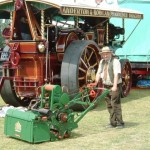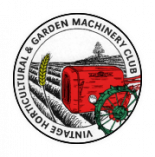Forum Replies Created
-
AuthorPosts
-
June 7, 2024 at 8:16 pm #42416
 hdtrustParticipant
hdtrustParticipantI would suggest your answer is in the title of your machine, the tractor unit was designed for one use, that of lawn mowing, nothing else.
Yes it will have certain power, but not the kind you are expecting, most certainly I would not stick a snow plough anywhere near it, as the chassis of the tractor is not designed for snow ploughing, you will only have to hit a raised bit of concrete under the snow and you will buckle the whole tractorMay 13, 2024 at 5:49 pm #42240 hdtrustParticipant
hdtrustParticipantHi send me some photos of your machine and the lawn
May 4, 2024 at 1:20 am #42196 hdtrustParticipant
hdtrustParticipantNice picture. This machine was introduced by Thomas Green of Leeds & London, known as a Greens Patent, also in the Patent it says Silens Messor (Silent running coming from the chain drive) The style of the chain drive on this machine depicts the Improvements which were added in 1862. From the picture it is difficult to work out the width of cut, but they were made in 3 sizes 24 – 26 and 30 inches to be pulled by a donkey.
Looking closely at the chain, its design is called inverted as there are forms of teeth which sits on the sprockets on the chain gear wheels.
By the 1870’s the design had altered again to what most people can recognize as a Green’s Silens Messor
Allowing for the history of photos, I would say the mower in the picture could have been 20 years old by the time the picture was takenApril 30, 2024 at 9:34 pm #42179 hdtrustParticipant
hdtrustParticipantThe rollers would have been only painted inside and the sides, not the surface area,(circumference) I have seen many painted which are incorrect, but again its your machine so ultimately its up to you! If you do paint and try and use it, you will find that the machine will not grip, and slip and slide.
April 15, 2024 at 9:51 pm #42091 hdtrustParticipant
hdtrustParticipantGuaranteed after shot blasting you will find more holes, its time to fabricate a new tank, as cost over time filling holes it will be a lot cheaper!
April 9, 2024 at 1:02 am #42043 hdtrustParticipant
hdtrustParticipantHi Andy, the term original is what it says, there is no term about it, its like scoring a goal, if it goes in the net then its a goal, if you miss it is not a goal.
When we restore machines, its back to how they were in a new state, as for parts if they are missing then we make them, we are always in the foundry picking up new castings. This is the problem with a lot of modern collectors, its ok purchasing a machine that is 50 years plus old but dont expect the parts to be sat on a dealers shelf waiting to be fitted!
Then there is the modern couch collector who thinks restoration is coating bare metal and flaky paint, with an oily rag, saying they are preserving for the future, there will be no future if the parts are warn. Or is it the case they are scared to strip it, but dont want to show their inadequateness in life!April 8, 2024 at 9:24 am #42041 hdtrustParticipant
hdtrustParticipantIt is your machine, it up to you, but normally it is to restore to the quality and looks when it was new, which is original condition,unfortunetly the saying original condition has been corrupted by a faction of vintage collectors to mean red rust covered in oil! To be left to the next generation to do the correct thing. When in fact all they are displaying is their ignorance to those in our movement to strive to save our history correctly
March 22, 2024 at 7:25 pm #41947 hdtrustParticipant
hdtrustParticipantFlymo’s were sold under various names, the one you have in the picture is a Flymo Contractor 52, 52 coming from the cutting width of the blade.
The engine should be an Aspera 122cc long life heavy duty, air cooled, third-port induction, loop scavenged two-stroke.
The one you are showing dates from the earliest 1975 – 1981
The engine speed is fixed at 3,300rpm, the carb has a diaphragm with a fixed jet and primer, don’t go pocking any wire into those jets, as you will ruin the engine!
They were sold by the lorry load to Councils for use on banks, I can remember quite clearly the wheels were great for travelling site to site, but that frame always got in the way on steep banks, times many we attached ropes to them, sending them down steep banks then pulling them back up on the rope and at the end of the day having arms the length of Orangutans!November 11, 2023 at 9:22 pm #41400 hdtrustParticipant
hdtrustParticipantThe original question was about the machine in the back ground, which I answered, I admit I did go on to try and identify the characters in the photo and earlier this year I did speak to Tony the originator of this question, my question to you Simonp are you a family member or the author of the book about the odd daughter of the Berners?
As for the steam mower I have a better picture of it in steam, and surprisingly enough, the machine still exists to this day, but alas I’m not going to divulge its whereabouts here!November 11, 2023 at 9:01 pm #41399 hdtrustParticipant
hdtrustParticipantBy the time you have added travelling time to the post office, and packing materials S T Bishop is a very good price for you, and also they have a very good track record, S T Bishops Son now runs the buisness but they still have a lot of dead stock hanging around, so probalby will be able to supply your bottom blade
October 17, 2023 at 10:21 pm #41315 hdtrustParticipant
hdtrustParticipantYes the roller requires stripping from the housing, so that you can get to the axle, there will be 2 main reasons for the roller not to spin, the first may well be to do with corrosion for not being used for years. Put the rollers vertical in a vice, then get diesel in a spray can and soak all around the axle and leave, if it still does not move you can always add a bit of heat.
The second problem could be that the roller has slipped on one of its journals, in this case caution must be observed as any use of ‘whitworth hammers’ could be a costly mistake. Again use diesel to free the roller parts, check whether the slide pin has moved position on the axle, if it has, then a new pin needs to be made. This is not uncommon on warn machinesSeptember 13, 2023 at 10:15 pm #41209 hdtrustParticipant
hdtrustParticipantYes the Stoic, I can remember from my apprentice days, made a good job on normal lengths of grass, but never try using one on thick grass in whip areas, or it will spend more time in the workshop than on the grass! To stop the engine having serious damage, there was a small aluminium slide pin that would shear on the flywheel, which would have to be swapped, a right pain, I can tell you, We even had a time for it, in our bonus books on the Council (somebody mention bonus!)
August 9, 2023 at 9:29 pm #41079 hdtrustParticipant
hdtrustParticipantYes the roofs of the marquees are hung up to dry for a few days before we can pack them away for the next show, good job we have very large barns where we store our show equipment
July 28, 2023 at 12:17 am #41010 hdtrustParticipant
hdtrustParticipantA nice example, I would say late 1930’s, these were sold by The Army and Navy Stores from their catalogues via their Victoria branch London
July 23, 2023 at 10:49 pm #40991 hdtrustParticipant
hdtrustParticipantA very interesting photo. Yes the mower in the back ground is a Leyland Steam Mower of 30 inch cut.
I know this photo well. The date of the photo is 1894 and it was taken at the first season at Woolerstone Cricket Club at their match against Colchester Garrison. In 1894 Woolerstone Hall was the seat of Charles Hugh Berners, High Steward of Harwich, Essex.
Charles Hugh Berners is the gentleman in the photo second from the left. His Son John A Berners is on the right in cricket flannels. In 1899 the England team played the Woolverstone team, at the Hall. In 1904 J.A. Berners played for Middlesex.
In 1937 Woolerstone Hall was sold. Was purchased by Lord Nuffield as an investment for Oxford University, in WW2 it was taken over and known as HMS Woolerstone, in the 1950’s it became a school and today its a large wedding venue! -
AuthorPosts
